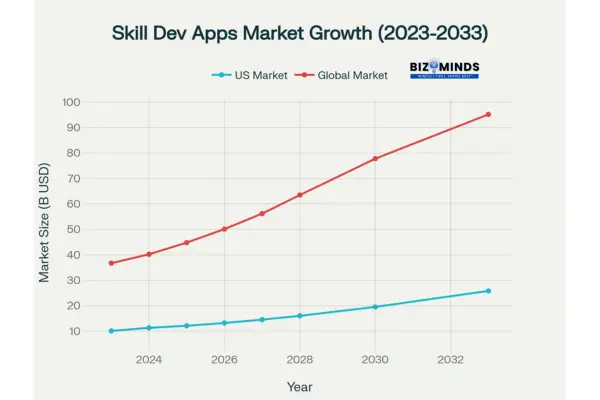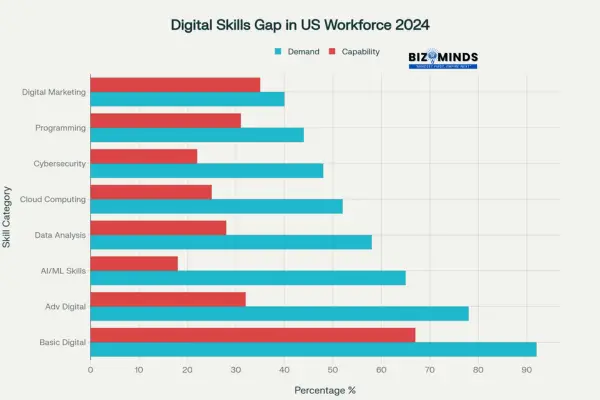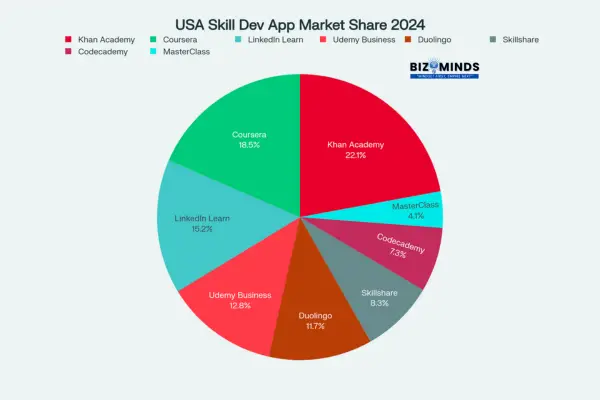

Skill Development Apps: How 92% of US Entrepreneurs Are Transforming Their Careers in 2025
The digital revolution has fundamentally transformed how Americans acquire and develop professional skills, with skill development apps emerging as powerful tools that bridge the gap between traditional education and the rapidly evolving demands of today’s economy. This transformative shift represents more than just technological advancement—it embodies the democratization of learning, providing entrepreneurs and job seekers across the United States with unprecedented access to career-enhancing resources that were once exclusive to formal educational institutions or expensive corporate training programs.

Market growth projection for skill development apps showing USA and global markets from 2023-2033
The $25.8 Billion Skill Development Apps Market: Growth Trends in USA
The skill development apps market in the United States has experienced remarkable growth, with the domestic market valued at $10.07 billion in 2024 and projected to reach $25.8 billion by 2033. This explosive growth trajectory, representing a compound annual growth rate (CAGR) of 6.15%, reflects not merely consumer preference but a fundamental shift in how Americans approach professional development.
Market Dynamics Driving Adoption
The convergence of several powerful forces has created an environment where skill development apps have become essential rather than optional tools for career advancement. The COVID-19 pandemic accelerated digital transformation initiatives across industries, while simultaneously highlighting the importance of continuous learning and adaptability. As organizations embraced remote and hybrid work models, the traditional boundaries between formal education and workplace learning began to blur, creating opportunities for innovative learning platforms to flourish.
The data highlights widespread adoption of digital training methods clearly:
- More than 70% of Fortune 500 companies today provide mobile learning solutions for their workforce
- Mobile learning can increase productivity by 45% compared to traditional training methods
- Completion rates for mobile learning are 45% higher than traditional e-learning approaches
- Organizations that implement mobile learning experience a 26% increase in revenue generated per employee
The democratization of skill development has particularly benefited entrepreneurs and job seekers who may not have access to traditional educational pathways or corporate training programs. These individuals can now access world-class instruction from leading universities and industry experts through platforms that cost a fraction of traditional education expenses.
How Skill Development Apps Are Closing America’s $975 Billion Skills Gap
The economic implications of widespread skill development apps adoption extend far beyond individual career advancement. Research from the National Skills Coalition reveals that 92% of jobs in the United States now require some level of digital skills, yet approximately one-third of workers lack these essential capabilities. This digital skills gap costs the US economy an estimated $975 billion in annual GDP, while closing this gap could create 5.1 million new jobs by 2028.
The role of skill development apps in addressing this challenge cannot be overstated. These platforms provide scalable, cost-effective solutions for upskilling and reskilling initiatives that can reach millions of workers simultaneously. For entrepreneurs launching new ventures, these apps offer critical business skills training that might otherwise require expensive MBA programs or consulting services. Job seekers benefit from targeted skill development that directly addresses market demands, improving their employability and earning potential.

Digital skills gap analysis showing demand vs current workforce capability across different skill categories
Top 8 Skill Development Apps Leading the US Market in 2025
The landscape of skill development apps in the United States is dominated by several key players, each serving distinct market segments while contributing to the overall ecosystem of digital learning. Understanding these platforms and their unique value propositions provides insight into how different types of learners—entrepreneurs, job seekers, and working professionals—can leverage these tools for career advancement.
LinkedIn Learning: Professional Skills for the Modern Workforce
LinkedIn Learning has emerged as a dominant force in professional skill development, with over 27 million users globally and a significant presence in the US market. The platform’s integration with the LinkedIn professional network creates a seamless experience where learning achievements directly enhance professional profiles, making it particularly valuable for job seekers and career changers.
The platform’s appeal stems from several key factors:
- Industry Relevance: Courses are developed in partnership with industry leaders and focus on skills that employers actively seek
- Professional Integration: Completed courses and certifications appear on LinkedIn profiles, providing immediate visibility to recruiters and employers
- Practical Application: Content emphasizes real-world application rather than theoretical knowledge
- Expert Instruction: Courses are taught by recognized industry experts and thought leaders
For entrepreneurs, LinkedIn Learning offers comprehensive business skill development covering everything from digital marketing and financial management to leadership and strategic planning. The platform’s business-focused curriculum helps startup founders develop the multifaceted skill sets required for successful venture creation and management.
Udemy Business: Comprehensive Skill Development at Scale
Udemy Business has captured significant market share through its vast course catalog and flexible learning approach. With over 77 million learners globally and strong representation in the US market, the platform offers more than 250,000 courses covering technology, business, personal development, and creative skills.
Key advantages of Udemy’s approach include:
- Diverse Content: Courses range from highly technical programming skills to soft skills development
- Affordable Access: Individual course purchases and subscription options make learning accessible to various budget levels
- Practical Focus: Many courses emphasize hands-on learning with real-world projects and applications
- Global Instructor Network: The platform’s open instructor model provides diverse perspectives and specialized expertise
The platform has proven particularly valuable for technology entrepreneurs and job seekers in STEM fields, offering current training in emerging technologies like artificial intelligence, cloud computing, and cybersecurity—skills that command premium salaries in the US job market.
Coursera: Academic Rigor Meets Professional Development
Coursera distinguishes itself through partnerships with top-tier universities and major corporations, offering courses, specializations, and degree programs that carry academic credibility. With 168.2 million registered learners and strong growth in degree programs, Coursera bridges the gap between traditional higher education and professional skill development.
The platform’s unique value proposition includes:
- Academic Credibility: Courses developed by prestigious institutions like Stanford, Yale, and MIT
- Career-Focused Programs: Google Career Certificates and IBM Professional Certificates provide direct pathways to employment
- Flexible Learning: Self-paced courses accommodate working professionals and busy entrepreneurs
- Measurable Outcomes: Research shows Coursera learners experience significant career advancement and salary increases
For job seekers, Coursera’s career certificates have become particularly valuable, with programs in high-demand fields like data analysis, digital marketing, and project management. These certificates are increasingly recognized by employers as equivalent to traditional credentials.

Market share distribution of top skill development platforms in the USA for 2024
Addressing the Skills Gap through Mobile Learning
The digital skills gap represents one of the most significant challenges facing the American workforce, with implications that extend from individual career prospects to national economic competitiveness. Skill development apps have emerged as a critical tool for addressing this challenge, providing scalable solutions that can reach underserved populations and deliver targeted training aligned with market demands.
Understanding the Scope of the Skills Challenge
Recent analysis reveals the breadth and depth of the skills gap facing American workers and employers. While 92% of jobs require digital skills, the current workforce capabilities fall significantly short of market demands across multiple skill categories. The gap is particularly pronounced in advanced digital skills, where only 32% of the workforce possesses the capabilities that 78% of jobs require.
The skills gap varies significantly across different categories:
- Basic Digital Skills: 25-point gap between demand (92%) and capability (67%)
- Advanced Digital Skills: 46-point gap between demand (78%) and capability (32%)
- AI/ML Skills: 47-point gap between demand (65%) and capability (18%)
- Data Analysis: 30-point gap between demand (58%) and capability (28%)
- Cloud Computing: 27-point gap between demand (52%) and capability (25%)
This skills gap disproportionately affects certain populations, including workers without college degrees, rural residents, and communities of color—groups that often face additional barriers to accessing traditional education and training programs.
Mobile Learning as an Equalizing Force
Skill development apps have demonstrated unique advantages in reaching underserved populations and providing accessible learning opportunities. The mobile-first approach eliminates many traditional barriers to education, including geographic constraints, scheduling conflicts, and high costs associated with formal training programs.
Success stories from across the United States illustrate the transformative potential of mobile learning:
AmSkills, a Tampa Bay-based organization, has leveraged mobile VR career exploration apps to reach job seekers in underserved communities. Their mobile Career Discovery Bootcamps bring training directly to community centers and schools, eliminating transportation barriers that often prevent participation in traditional training programs. The results have been remarkable: 102 of 146 participants (70%) found employment in high-growth manufacturing industries, with many discovering career paths they had never previously considered.
The organization’s approach demonstrates how skill development apps can complement and enhance traditional workforce development efforts. By using VR simulations, participants can safely explore dangerous industrial equipment and processes without the need for expensive physical training facilities. This combination of mobile accessibility and immersive technology has proven particularly effective with younger learners who have grown up with gaming and digital interfaces.
Essential Skill Development Apps Every USA Entrepreneur Needs for Business Success
For entrepreneurs, skill development apps provide essential training across the diverse competencies required for successful venture creation and management. Unlike traditional business education, which often focuses on theoretical frameworks, these platforms emphasize practical, actionable skills that can be immediately applied to real business challenges.
Critical entrepreneurial skills addressed through mobile learning include:
Digital Marketing Mastery:
Platforms like Coursera offer Google Digital Marketing Certification programs that teach entrepreneurs how to reach customers through search engines, social media, and content marketing
Financial Management:
Comprehensive training in accounting, financial modeling, and investment analysis helps entrepreneurs make informed business decisions
Technology Skills:
Programming, web development, and digital tool proficiency enable entrepreneurs to build and scale technology-enabled businesses
Leadership Development:
Management and team-building skills essential for scaling organizations beyond the founder stage
The flexibility of mobile learning particularly benefits entrepreneurs, who often work irregular schedules and need to balance learning with the demands of building their businesses. The ability to access high-quality instruction during commutes, between meetings, or during other downtime maximizes learning efficiency without sacrificing business development activities.
Return on Investment: Measuring Success and Impact
The adoption of skill development apps by individuals and organizations represents a significant investment of time and resources, making return on investment (ROI) measurement critical for understanding their true value. Recent research and case studies from across the United States provide compelling evidence of the substantial returns generated through strategic skill development app implementation.
Individual ROI: How Skill Development Apps Increase Salaries by 25%
For individual learners, the ROI of skill development apps can be measured through career advancement, salary increases, and expanded employment opportunities. Longitudinal studies tracking app users reveal consistent patterns of professional growth and increased earning potential following completion of structured learning programs.
Key ROI metrics for individual learners include:
- Certification program graduates typically see salary boosts ranging from 15% to 25% within 6 to 12 months
- Career transition success rates of 70-80% for learners seeking to change industries or roles
- Promotion rates 2.5x higher among employees who actively engage with learning platforms compared to those who don’t
- Time-to-employment reduction of 30-50% for job seekers who complete relevant skill development programs
The healthcare sector provides particularly compelling examples of individual ROI. A medium-sized healthcare provider in the Midwest created partnerships with technical colleges to develop nursing assistant training programs delivered through mobile learning platforms. This initiative produced 200 new qualified nursing assistants while removing traditional experience requirements, demonstrating how skill-first approaches can create pathways into high-demand professions.
Organizational ROI: Efficiency and Competitive Advantage
Organizations implementing skill development apps for employee training and development report substantial returns across multiple dimensions, including reduced training costs, improved employee retention, and enhanced operational efficiency.
Quantifiable organizational benefits include:
- Training cost reductions of 40-60% compared to traditional instructor-led programs
- Training time reductions of 37-60%, allowing employees to return to productive work faster
- Employee retention improvements of 34%, particularly among workers without traditional four-year degrees
- Productivity increases of 45% among employees participating in mobile learning initiatives
A telecommunications company case study illustrates these benefits in practice. By implementing mobile learning for field technicians, the company provided just-in-time access to troubleshooting guides and instructional videos. This initiative resulted in a 15% improvement in first-time fix rates and increased customer satisfaction, while reducing the need for expensive in-person training sessions.
Economic Impact on Regional Development
The wider economic effects of skill development applications go beyond personal and corporate advantages, contributing significantly to regional growth and enhancing workforce competitiveness. States and metropolitan areas that have embraced skills-based approaches report measurable improvements in employment rates, wage growth, and business attraction.
Regional economic benefits include:
- Expanded talent pools for employers, with 2-4x increases in qualified applicants for skills-based job postings
- Reduced hiring time and costs as employers can more effectively identify candidates with relevant capabilities
- Industry cluster development as regions build specialized skill concentrations that attract related businesses
- Innovation ecosystem growth as entrepreneurs and workers develop the technical skills necessary for high-growth ventures
Maryland’s statewide initiative to remove degree requirements from approximately 50% of government positions demonstrates the potential for policy-driven skills-first approaches. By opening thousands of jobs in healthcare, corrections, skilled trades, and engineering to a broader applicant pool, the state expanded opportunities for workers while addressing critical staffing shortages.
Future of Skill Development Apps: AI, VR, and Blockchain Innovations in 2025
The landscape of skill development apps continues to evolve rapidly, driven by technological innovations, changing workforce needs, and evolving pedagogical approaches. Understanding emerging trends provides insight into how these platforms will continue to transform learning and development for American entrepreneurs and job seekers.
Artificial Intelligence and Personalized Learning
Artificial intelligence integration represents the most significant technological advancement in skill development apps, enabling unprecedented levels of personalization and adaptive learning. Modern AI systems can analyze learning patterns, identify knowledge gaps, and adjust content delivery to optimize individual learning outcomes.
AI-powered features transforming the learning experience include:
- Adaptive Learning Paths: Systems that automatically adjust difficulty and content based on learner performance and preferences
- Intelligent Content Curation: AI algorithms that recommend courses and resources based on career goals, industry trends, and skill gaps
- Real-Time Performance Analytics: Continuous assessment and feedback systems that identify areas for improvement and suggest remediation strategies
- Natural Language Processing: Chatbots and virtual assistants that provide instant support and answer learner questions
LinkedIn Learning’s AI-powered recommendation engine exemplifies these capabilities, analyzing professional profiles, job market trends, and learning history to suggest relevant courses and skill development opportunities. This personalization increases engagement rates and improves learning outcomes by ensuring content relevance.
Virtual and Augmented Reality Integration
Immersive technologies are revolutionizing skill development by providing realistic, hands-on learning experiences that were previously impossible through traditional digital platforms. VR and AR applications are particularly valuable for technical skills training, where learners can practice with expensive or dangerous equipment in safe, controlled environments.
Innovative applications of immersive technologies include:
- Industrial Training Simulations: VR environments that allow learners to operate complex machinery and practice safety procedures without physical risk
- Soft Skills Development: Simulated interpersonal scenarios for practicing communication, negotiation, and leadership skills
- Medical and Healthcare Training: Realistic patient simulations and surgical procedures that provide hands-on experience without patient risk
- Entrepreneurship Simulations: Virtual business environments where aspiring entrepreneurs can test strategies and learn from failures without financial consequences
The AmSkills program in Tampa Bay demonstrates the practical applications of VR in workforce development. Their mobile VR career exploration initiative has helped hundreds of job seekers discover manufacturing careers through realistic simulations, achieving a 70% job placement rate while eliminating the need for expensive physical training equipment.
Blockchain and Credential Verification
Blockchain technology is addressing one of the most significant challenges in skill development: credential verification and portability. As learners complete courses and certifications across multiple platforms, blockchain-based systems provide secure, verifiable records of achievements that can be easily shared with employers and educational institutions.
Blockchain applications in skill development include:
- Secure Credential Storage: Tamper-proof digital certificates that learners own and control
- Cross-Platform Recognition: Standardized formats that enable credential recognition across different learning platforms and employers
- Micro-Credential Systems: Granular skill verification that provides detailed evidence of specific capabilities
- Professional Portfolio Management: Comprehensive skill profiles that integrate formal education, professional experience, and continuous learning activities
Social Learning and Community Building
The evolution of skill development apps increasingly emphasizes social learning and community building, recognizing that peer interaction and collaborative learning enhance engagement and knowledge retention. Modern platforms integrate social features that connect learners with similar interests, career goals, and geographic locations.
Social learning innovations include:
- Peer-to-Peer Learning Networks: Platforms that connect learners for mutual support and knowledge sharing
- Industry-Specific Communities: Specialized groups focused on particular sectors or skill areas
- Mentorship Matching: AI-powered systems that connect learners with experienced professionals for guidance and support
- Collaborative Project Platforms: Environments where learners can work together on real-world challenges and build portfolios
These social elements are particularly valuable for entrepreneurs, who benefit from networking opportunities and peer support as they navigate the challenges of building new ventures. The combination of skill development and community building creates ecosystems that support both individual learning and collective innovation.
Common Challenges When Using Skill Development Apps (And How to Overcome Them)
While skill development apps offer tremendous opportunities for American entrepreneurs and job seekers, their implementation and effectiveness face several significant challenges that must be addressed to maximize their potential impact. Understanding these challenges enables learners, organizations, and policymakers to make informed decisions and develop strategies for overcoming potential barriers.
Digital Divide and Access Inequality
Despite the widespread adoption of mobile technology, significant disparities in digital access and literacy continue to limit the reach and effectiveness of skill development apps. These disparities disproportionately affect the populations who could benefit most from accessible learning opportunities, including low-income workers, rural residents, and older adults.
Key access barriers include:
- Device and Internet Connectivity: While smartphone ownership is widespread, reliable high-speed internet access remains limited in rural areas and lower-income communities
- Digital Literacy: Basic computer and internet skills necessary for effective app navigation and learning
- Language and Cultural Barriers: Limited availability of content in languages other than English and cultural relevance for diverse learner populations
- Accommodation Needs: Accessibility features for learners with disabilities often lag behind mainstream platform development
The National Skills Coalition’s research reveals that 40% of adults in the United States lack basic digital skills, creating a fundamental barrier to accessing app-based learning opportunities. This challenge is particularly acute in rural areas, where broadband infrastructure limitations compound digital literacy deficits.
Quality Assurance and Credentialing
The democratization of content creation enabled by many skill development platforms has led to concerns about course quality and credibility. With millions of courses available across various platforms, learners face significant challenges in identifying high-quality, current, and relevant content that will provide genuine career advancement opportunities.
Quality-related challenges include:
- Content Verification: Difficulty distinguishing between evidence-based, expert-developed content and amateur or outdated materials
- Instructor Qualifications: Limited standardization of instructor credentials and teaching effectiveness across platforms
- Industry Recognition: Varying levels of employer acceptance for different platforms and certification programs
- Currency and Relevance: Rapid technological change that can make course content obsolete quickly
The variations in employer recognition represent a particular challenge for job seekers investing time and resources in skill development. While Google Career Certificates and IBM Professional Certificates enjoy broad industry acceptance, many other certifications lack similar recognition, potentially limiting their career impact.
Motivation and Completion Challenges
Despite their convenience and accessibility, skill development apps face significant challenges related to learner motivation and course completion. The self-directed nature of app-based learning, while providing flexibility, also places greater responsibility on individual learners to maintain engagement and complete programs.
Motivation-related barriers include:
- Self-Direction Requirements: Many learners struggle without the structure and accountability provided by traditional classroom settings
- Information Overload: The vast array of available courses can lead to decision paralysis and lack of focused learning paths
- Time Management: Balancing learning activities with work, family, and other responsibilities
- Immediate Application Challenges: Difficulty connecting theoretical learning to practical workplace application
Research indicates that completion rates for online courses vary significantly, with some platforms reporting completion rates as low as 15% for self-paced courses. However, mobile learning platforms that incorporate gamification, social elements, and practical projects typically achieve higher engagement and completion rates.
Integrating Skill Development Apps with Traditional Education Systems
The relationship between skill development apps and traditional education and workforce development systems remains complex and often poorly integrated. This lack of coordination can limit the effectiveness of both approaches and create confusion for learners navigating multiple pathways to skill development.
Integration challenges include:
- Credit Transfer: Limited recognition of app-based learning by traditional educational institutions
- Workforce System Coordination: Poor integration between public workforce development programs and commercial learning platforms
- Career Counseling: Insufficient guidance for learners in selecting appropriate courses and creating coherent skill development plans
- Employer Engagement: Limited employer involvement in course design and outcome validation
Successful integration examples, such as the partnerships between AmSkills and local technical colleges, demonstrate the potential for combining mobile learning with traditional workforce development approaches. However, such collaborations remain the exception rather than the rule, limiting their potential impact.
Recommendations for Maximizing Impact
Based on extensive research and analysis of successful implementations across the United States, several key recommendations emerge for maximizing the impact of skill development apps for entrepreneurs and job seekers. These recommendations address both individual learning strategies and systemic improvements needed to enhance the effectiveness of app-based skill development.
Individual Learning Strategies
For entrepreneurs and job seekers seeking to maximize their return on investment in skill development apps, strategic approach and disciplined execution are essential.
- Conduct Skills Gap Analysis: Before investing in learning platforms, conduct thorough assessments of current capabilities, career goals, and market demands to identify the most valuable skill development priorities
- Create Structured Learning Plans: Develop comprehensive learning plans with specific milestones, timelines, and practical application opportunities rather than pursuing random courses
- Combine Multiple Platforms: Leverage the unique strengths of different platforms—using LinkedIn Learning for professional skills, Coursera for academic rigor, and Udemy for technical specializations
- Emphasize Practical Application: Prioritize courses that include hands-on projects, real-world case studies, and portfolio development opportunities
- Build Learning Communities: Actively participate in platform communities, discussion forums, and peer learning opportunities to enhance engagement and knowledge retention
Organizational Implementation Strategies
Organizations seeking to implement skill development apps for workforce development should focus on strategic alignment and comprehensive support systems.
- Align with Business Objectives: Ensure learning initiatives directly support organizational goals and address specific skill gaps identified through workforce planning processes
- Provide Comprehensive Support: Offer technical support, learning time allocation, and manager engagement to support employee success
- Measure and Track Outcomes: Implement robust analytics and tracking systems to measure learning effectiveness, skill acquisition, and business impact
- Create Career Pathways: Develop clear connections between skill development activities and career advancement opportunities within the organization
- Foster Learning Culture: Encourage continuous learning through recognition programs, peer sharing opportunities, and leadership modeling
Policy and System-Level Improvements
Systemic improvements are needed to maximize the societal impact of skill development apps and ensure equitable access to learning opportunities.
Infrastructure and Access
- Expand Broadband Access: Continued investment in rural and underserved urban broadband infrastructure to enable universal access to app-based learning
- Digital Literacy Programs: Comprehensive digital literacy training integrated with skill development initiatives
- Device Access Programs: Public-private partnerships to provide devices and internet access for underserved populations
Quality and Standards
- Develop Quality Standards: Industry-wide standards for course quality, instructor qualifications, and learning outcome measurement
- Enhance Employer Engagement: Programs to increase employer involvement in course design, validation, and recognition
- Improve Career Guidance: Enhanced career counseling and guidance services to help learners navigate complex learning options and career pathways
Integration and Coordination
- Workforce System Integration: Better coordination between public workforce development programs and commercial learning platforms
- Credit Recognition: Expanded recognition of app-based learning by educational institutions and employers
- Data Integration: Improved data sharing and integration to track learner outcomes and program effectiveness across platforms and systems
Conclusion
The transformation of American workforce development through skill development apps represents one of the most significant educational innovations of the digital age. These platforms have democratized access to high-quality learning opportunities, providing entrepreneurs and job seekers with unprecedented flexibility to acquire the skills needed for economic success in a rapidly evolving economy.
The evidence presented throughout this analysis demonstrates the substantial impact these platforms are having on individual careers, organizational effectiveness, and regional economic development. With the US market projected to reach $25.8 billion by 2033 and mobile learning delivering measurable ROI through increased productivity, reduced training costs, and improved employment outcomes, skill development apps have moved beyond experimental tools to become essential infrastructure for workforce development.
The success stories from AmSkills’ 70% job placement rate using mobile VR training to the telecommunications company’s 15% improvement in first-time fix rates through just-in-time mobile learning illustrate the practical, real-world impact these platforms can achieve. Similarly, the statewide initiatives in Maryland and the corporate implementations across Fortune 500 companies demonstrate the scalability and broad applicability of app-based learning approaches.
However, realizing the full potential of this transformation requires addressing significant challenges related to digital access, quality assurance, and system integration. The digital divide continues to limit opportunities for underserved populations, while quality variations across platforms and limited employer recognition create barriers to effective implementation. Success will require coordinated efforts across multiple stakeholders to ensure equitable access, maintain high standards, and integrate app-based learning with traditional education and workforce development systems.
For entrepreneurs and job seekers, skill development apps offer an unprecedented opportunity to acquire market-relevant capabilities quickly and cost-effectively. The key to success lies in strategic selection of platforms and courses, disciplined learning approaches, and practical application of acquired skills. As AI, VR, and blockchain technologies continue to enhance these platforms, the learning experience will become even more personalized, immersive, and credible.
Organizations and policymakers have crucial roles to play in maximizing the societal impact of skill development apps. By investing in infrastructure, developing quality standards, and creating supportive ecosystems that connect learning to career opportunities, they can ensure that these powerful tools contribute to broadly shared-economic prosperity rather than exacerbating existing inequalities.
The future of American workforce development increasingly depends on our ability to harness the potential of skill development apps while addressing their limitations. As the pace of technological and economic change continues to accelerate, these platforms will become even more critical for helping workers adapt and thrive. The commitments made now to increase access, enhance quality, and align these tools with wider workforce development initiatives will shape the success of this educational revolution in enabling all Americans to thrive in the digital economy.
Frequently Asked Questions (FAQs)
1. What are skill development apps and how do they differ from traditional learning platforms?
Skill development apps are mobile-first learning platforms designed to deliver professional and technical training through smartphones, tablets, and other mobile devices. Unlike traditional e-learning platforms that typically require desktop computers, these apps provide bite-sized, interactive content optimized for mobile consumption. They emphasize practical, job-relevant skills over theoretical knowledge and often incorporate gamification, social learning, and personalized learning paths. The key difference lies in their accessibility, flexibility, and focus on immediate application rather than comprehensive academic coverage.
2. Which skill development apps are most popular among American entrepreneurs and job seekers?
The leading platforms in the US market include LinkedIn Learning (15.2% market share), Coursera (18.5% market share), Khan Academy (22.1% market share), Udemy Business (12.8% market share), and Duolingo (11.7% market share). LinkedIn Learning is particularly popular among professionals for business skills, Coursera offers university-level courses with academic credibility, Udemy Business provides extensive technical training, Khan Academy focuses on foundational skills, and Duolingo dominates language learning. Selecting a platform typically hinges on individual career objectives, preferred learning styles, and budget constraints.
3. What is the typical return on investment (ROI) for individuals using skill development apps?
Research indicates that individuals using skill development apps can expect significant returns on their investment. Average salary increases range from 15-25% within 6-12 months of completing certification programs, while career transition success rates reach 70-80% for those seeking to change industries or roles. Job seekers experience 30-50% faster time-to-employment, and employees who actively engage with learning platforms have promotion rates 2.5 times higher than those who don’t. The specific ROI varies based on the individual’s starting point, chosen skills, and market demand for those capabilities.
4. How effectively do skill development apps support overcoming the digital skills deficit in the USA?
Skill development apps directly address the digital skills gap by providing accessible, affordable training in high-demand digital competencies. With 92% of US jobs requiring digital skills but only 67% of workers possessing basic digital capabilities, these apps offer scalable solutions for upskilling and reskilling. They provide training in critical areas like data analysis, cloud computing, cybersecurity, and programming—skills where significant gaps exist between employer demand and workforce capability. The mobile-first approach eliminates geographic and scheduling barriers that often prevent access to traditional training programs.
5. Are certifications from skill development apps recognized by employers?
Recognition varies significantly by platform and certification type. Google Career Certificates, IBM Professional Certificates, and courses from accredited institutions through Coursera generally enjoy broad employer recognition. LinkedIn Learning certificates enhance professional profiles and are visible to recruiters through the LinkedIn platform. However, many other platform certifications have limited formal recognition, making it important to research employer acceptance in specific industries before investing time and resources. The trend is toward increased recognition as employers adopt skills-based hiring practices.
6. How much do skill development apps typically cost, and are there free options available?
Costs vary widely across platforms and subscription models. LinkedIn Learning costs $29.99/month, Coursera ranges from $49-79/month for specializations, Udemy Business charges approximately $30/month for teams, and individual Udemy courses range from $10-200. Free options include Khan Academy, basic Coursera courses (with fees for certificates), Duolingo, and many YouTube educational channels. Many platforms offer free trials, financial aid programs, and occasional free access to premium content during promotional periods.
7. What challenges do learners face when using skill development apps?
Common challenges include maintaining motivation without structured classroom environments, selecting high-quality courses from vast catalogs, finding time for consistent learning while balancing work and personal responsibilities, and applying theoretical knowledge to practical work situations. Technical challenges include device limitations, internet connectivity issues (particularly in rural areas), and navigating complex platform interfaces. Many learners also struggle with information overload and creating coherent learning paths that align with their career goals.
8. How can entrepreneurs best leverage skill development apps for business success?
Entrepreneurs should focus on acquiring diverse skills across multiple business functions, including digital marketing, financial management, technology literacy, and leadership development. The key is creating structured learning plans that address immediate business needs while building long-term capabilities. Entrepreneurs benefit from platforms that offer practical, project-based learning that can be immediately applied to their ventures. Combining multiple platforms—using LinkedIn Learning for professional skills, Coursera for strategic thinking, and Udemy for technical capabilities—often provides the most comprehensive skill development.
9. What role does artificial intelligence play in modern skill development apps?
AI is transforming skill development apps through personalized learning paths that adapt to individual performance and preferences, intelligent content recommendations based on career goals and market trends, real-time performance analytics that identify knowledge gaps and suggest improvements, and natural language processing for instant support through chatbots. AI enables platforms to deliver customized learning experiences that optimize engagement and outcomes while providing insights into learning effectiveness and skill acquisition patterns.
10. How do skill development apps support remote and hybrid workforce training?
Skill development apps are particularly well-suited for remote and hybrid workforce training because they provide flexible, on-demand access to learning content that employees can consume from any location. Features like offline content download, mobile optimization, progress tracking across devices, and integration with corporate learning management systems make them ideal for distributed teams. Organizations report 40-60% cost savings compared to traditional training methods, while employees appreciate the ability to learn during commutes, breaks, or other convenient times.
11. What emerging technologies will shape the future of skill development apps?
Virtual and Augmented Reality (VR/AR) are enabling immersive, hands-on learning experiences for technical skills training, blockchain technology is providing secure, verifiable credential storage and recognition, advanced AI is creating increasingly sophisticated personalization and adaptive learning capabilities, and social learning features are building communities around shared learning goals. These technologies will make learning more engaging, credible, and connected to real-world applications while maintaining the accessibility and flexibility that make mobile learning attractive.
12. How can organizations measure the effectiveness of skill development app implementations?
Organizations should track multiple metrics including course completion rates, skill acquisition assessments, employee performance improvements, promotion and retention rates, and business outcomes like productivity gains and revenue per employee. Key performance indicators include training cost reductions (typically 40-60%), training time reductions (37-60%), employee engagement scores, and practical application of learned skills in work contexts. Regular surveys, performance reviews, and business impact analysis provide comprehensive views of program effectiveness and return on investment.








